HYUNDAI IX35 2016 Repair Manual
Manufacturer: HYUNDAI, Model Year: 2016, Model line: IX35, Model: HYUNDAI IX35 2016Pages: 550, PDF Size: 9.92 MB
Page 61 of 550
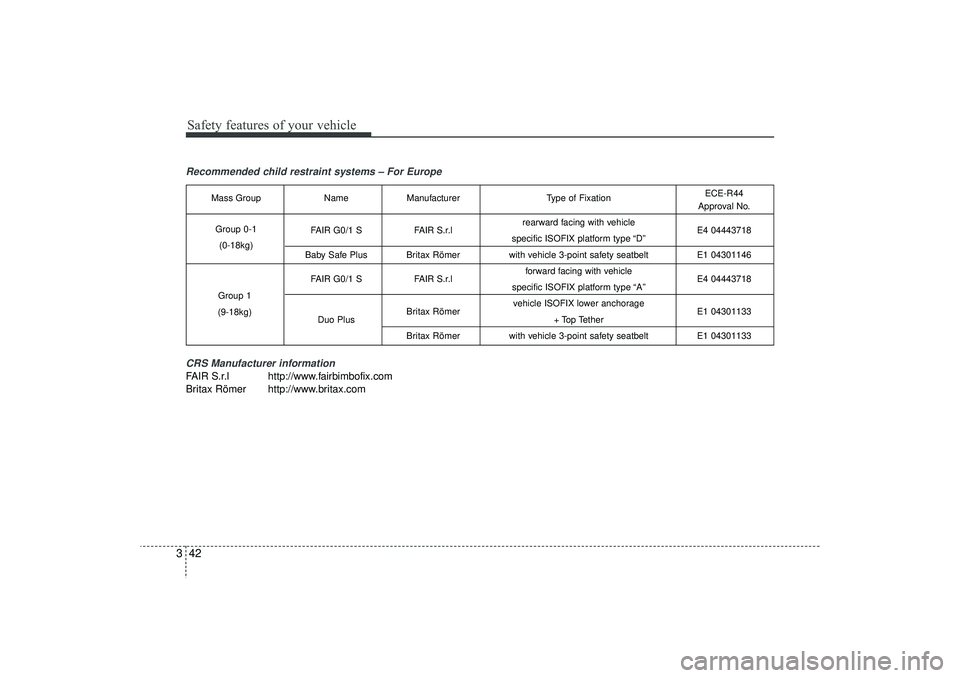
Safety features of your vehicle42
3Recommended child restraint systems – For Europe
CRS Manufacturer informationFAIR S.r.l http://www.fairbimbofix.com
Britax Römer http://www.britax.com
Mass Group NameManufacturer Type of Fixation ECE-R44
Approval No.
Group 0-1 FAIR G0/1 S FAIR S.r.l rearward facing with vehicle
E4 04443718
(0-18kg) specific ISOFIX platform type “D”
Baby Safe Plus Britax Römer with vehicle 3-point safety seatbeltE1 04301146
FAIR G0/1 S FAIR S.r.l forward facing with vehicle
E4 04443718
specific ISOFIX platform type “A”
Britax Römer vehicle ISOFIX lower anchorage
E1 04301133
Duo Plus + Top Tether
Britax Römer with vehicle 3-point safety seatbelt E1 04301133Group 1
(9-18kg)
EL(FL) UK 3.QXP 12/16/2014 8:56 PM Page 42
Page 62 of 550
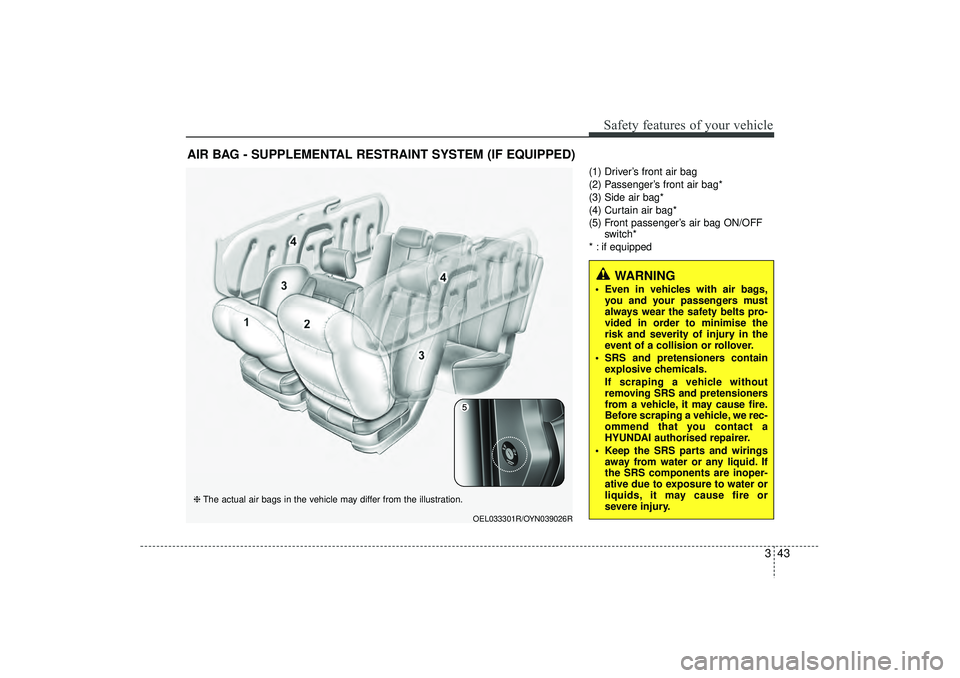
343
Safety features of your vehicle
(1) Driver’s front air bag
(2) Passenger’s front air bag*
(3) Side air bag*
(4) Curtain air bag*
(5) Front passenger’s air bag ON/OFFswitch*
* : if equipped
AIR BAG - SUPPLEMENTAL RESTRAINT SYSTEM (IF EQUIPPED)
WARNING
Even in vehicles with air bags, you and your passengers must
always wear the safety belts pro-
vided in order to minimise the
risk and severity of injury in the
event of a collision or rollover.
SRS and pretensioners contain explosive chemicals.
If scraping a vehicle without
removing SRS and pretensioners
from a vehicle, it may cause fire.
Before scraping a vehicle, we rec-
ommend that you contact a
HYUNDAI authorised repairer.
Keep the SRS parts and wirings away from water or any liquid. If
the SRS components are inoper-
ative due to exposure to water or
liquids, it may cause fire or
severe injury.
OEL033301R/OYN039026R
❈ The actual air bags in the vehicle may differ from the illustration.
EL(FL) UK 3.QXP 12/16/2014 8:56 PM Page 43
Page 63 of 550
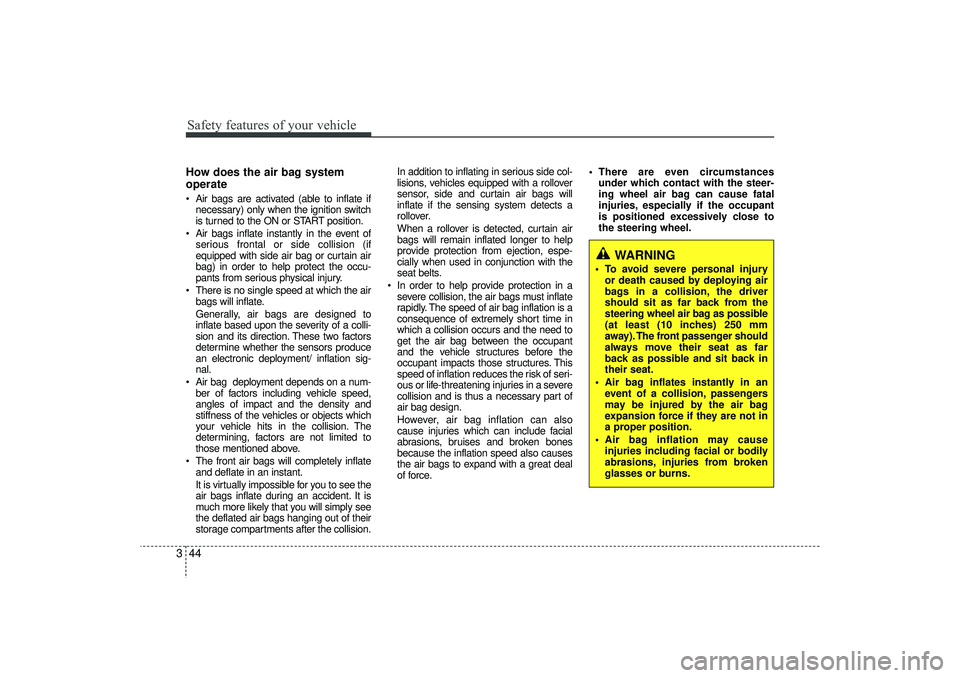
Safety features of your vehicle44
3How does the air bag system
operate Air bags are activated (able to inflate if
necessary) only when the ignition switch
is turned to the ON or START position.
Air bags inflate instantly in the event of serious frontal or side collision (if
equipped with side air bag or curtain air
bag) in order to help protect the occu-
pants from serious physical injury.
There is no single speed at which the air bags will inflate.
Generally, air bags are designed to
inflate based upon the severity of a colli-
sion and its direction. These two factors
determine whether the sensors produce
an electronic deployment/ inflation sig-
nal.
Air bag deployment depends on a num- ber of factors including vehicle speed,
angles of impact and the density and
stiffness of the vehicles or objects which
your vehicle hits in the collision. The
determining, factors are not limited to
those mentioned above.
The front air bags will completely inflate and deflate in an instant.
It is virtually impossible for you to see the
air bags inflate during an accident. It is
much more likely that you will simply see
the deflated air bags hanging out of their
storage compartments after the collision. In addition to inflating in serious side col-
lisions, vehicles equipped with a rollover
sensor, side and curtain air bags will
inflate if the sensing system detects a
rollover.
When a rollover is detected, curtain air
bags will remain inflated longer to help
provide protection from ejection, espe-
cially when used in conjunction with the
seat belts.
In order to help provide protection in a severe collision, the air bags must inflate
rapidly. The speed of air bag inflation is a
consequence of extremely short time in
which a collision occurs and the need to
get the air bag between the occupant
and the vehicle structures before the
occupant impacts those structures. This
speed of inflation reduces the risk of seri-
ous or life-threatening injuries in a severe
collision and is thus a necessary part of
air bag design.
However, air bag inflation can also
cause injuries which can include facial
abrasions, bruises and broken bones
because the inflation speed also causes
the air bags to expand with a great deal
of force. There are even circumstances
under which contact with the steer-
ing wheel air bag can cause fatal
injuries, especially if the occupant
is positioned excessively close to
the steering wheel.
WARNING
To avoid severe personal injuryor death caused by deploying air
bags in a collision, the driver
should sit as far back from the
steering wheel air bag as possible
(at least (10 inches) 250 mm
away). The front passenger should
always move their seat as far
back as possible and sit back in
their seat.
Air bag inflates instantly in an event of a collision, passengers
may be injured by the air bag
expansion force if they are not in
a proper position.
Air bag inflation may cause injuries including facial or bodily
abrasions, injuries from broken
glasses or burns.
EL(FL) UK 3.QXP 12/16/2014 8:56 PM Page 44
Page 64 of 550
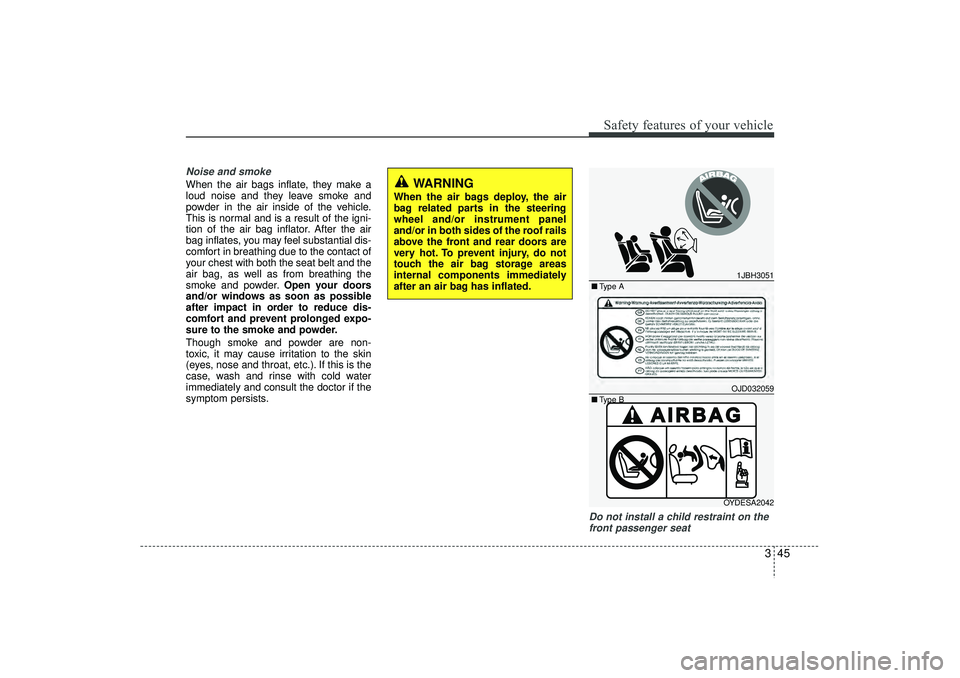
345
Safety features of your vehicle
Noise and smokeWhen the air bags inflate, they make a
loud noise and they leave smoke and
powder in the air inside of the vehicle.
This is normal and is a result of the igni-
tion of the air bag inflator. After the air
bag inflates, you may feel substantial dis-
comfort in breathing due to the contact of
your chest with both the seat belt and the
air bag, as well as from breathing the
smoke and powder.Open your doors
and/or windows as soon as possible
after impact in order to reduce dis-
comfort and prevent prolonged expo-
sure to the smoke and powder.
Though smoke and powder are non-
toxic, it may cause irritation to the skin
(eyes, nose and throat, etc.). If this is the
case, wash and rinse with cold water
immediately and consult the doctor if the
symptom persists.
Do not install a child restraint on the front passenger seat
WARNING
When the air bags deploy, the air
bag related parts in the steering
wheel and/or instrument panel
and/or in both sides of the roof rails
above the front and rear doors are
very hot. To prevent injury, do not
touch the air bag storage areas
internal components immediately
after an air bag has inflated.
1JBH3051OJD032059OYDESA2042
■ Type A
■ Type B
EL(FL) UK 3.QXP 12/16/2014 8:56 PM Page 45
Page 65 of 550
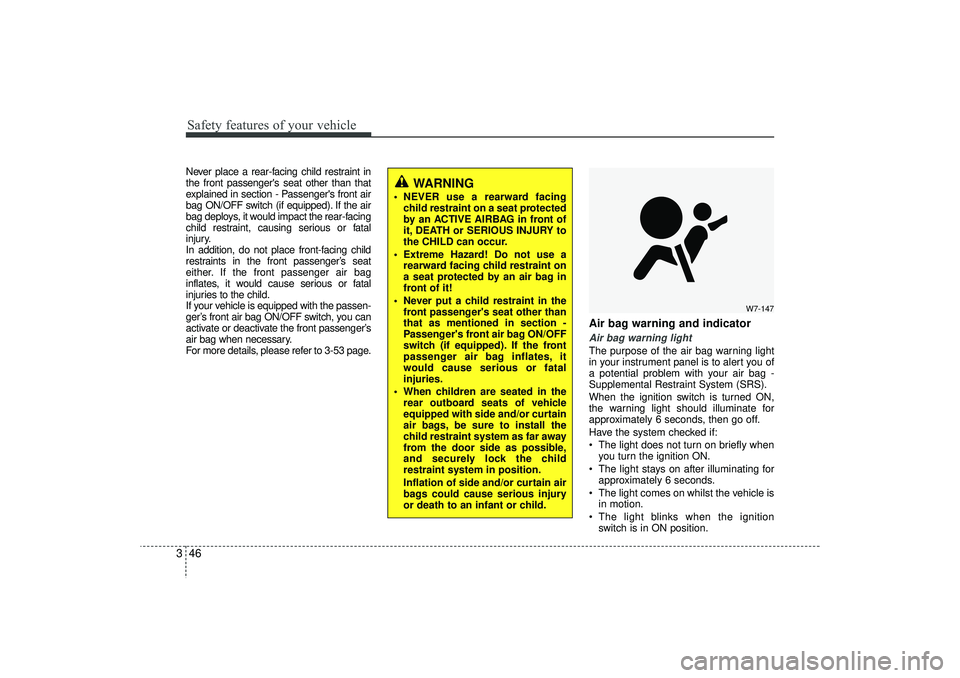
Safety features of your vehicle46
3Never place a rear-facing child restraint in
the front passenger's seat other than that
explained in section - Passenger's front air
bag ON/OFF switch (if equipped). If the air
bag deploys, it would impact the rear-facing
child restraint, causing serious or fatal
injury.
In addition, do not place front-facing child
restraints in the front passenger’s seat
either. If the front passenger air bag
inflates, it would cause serious or fatal
injuries to the child.
If your vehicle is equipped with the passen-
ger’s front air bag ON/OFF switch, you can
activate or deactivate the front passenger’s
air bag when necessary.
For more details, please refer to 3-53 page.
Air bag warning and indicatorAir bag warning lightThe purpose of the air bag warning light
in your instrument panel is to alert you of
a potential problem with your air bag -
Supplemental Restraint System (SRS).
When the ignition switch is turned ON,
the warning light should illuminate for
approximately 6 seconds, then go off.
Have the system checked if:
The light does not turn on briefly when
you turn the ignition ON.
The light stays on after illuminating for approximately 6 seconds.
The light comes on whilst the vehicle is in motion.
The light blinks when the ignition switch is in ON position.
WARNING
• NEVER use a rearward facingchild restraint on a seat protected
by an ACTIVE AIRBAG in front of
it, DEATH or SERIOUS INJURY to
the CHILD can occur.
Extreme Hazard! Do not use a rearward facing child restraint on
a seat protected by an air bag in
front of it!
Never put a child restraint in the front passenger's seat other than
that as mentioned in section -
Passenger's front air bag ON/OFF
switch (if equipped). If the front
passenger air bag inflates, it
would cause serious or fatal
injuries.
When children are seated in the rear outboard seats of vehicle
equipped with side and/or curtain
air bags, be sure to install the
child restraint system as far away
from the door side as possible,
and securely lock the child
restraint system in position.
Inflation of side and/or curtain air
bags could cause serious injury
or death to an infant or child.
W7-147
EL(FL) UK 3.QXP 2/11/2015 4:18 PM Page 46
Page 66 of 550
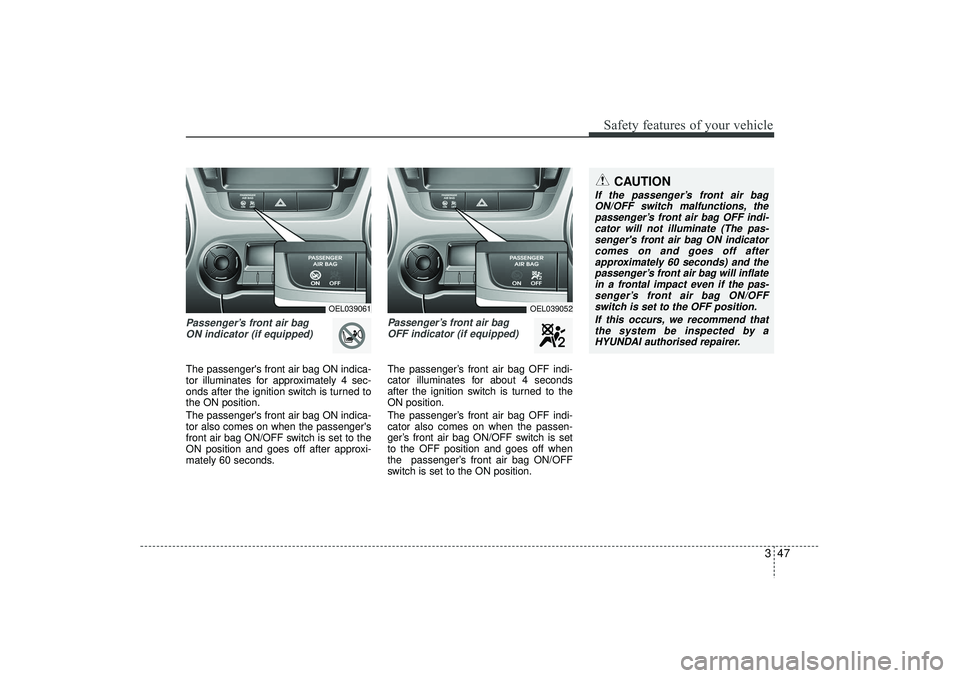
347
Safety features of your vehicle
Passenger’s front air bag ON indicator (if equipped)The passenger's front air bag ON indica-
tor illuminates for approximately 4 sec-
onds after the ignition switch is turned to
the ON position.
The passenger's front air bag ON indica-
tor also comes on when the passenger's
front air bag ON/OFF switch is set to the
ON position and goes off after approxi-
mately 60 seconds.
Passenger’s front air bag OFF indicator (if equipped)The passenger’s front air bag OFF indi-
cator illuminates for about 4 seconds
after the ignition switch is turned to the
ON position.
The passenger’s front air bag OFF indi-
cator also comes on when the passen-
ger’s front air bag ON/OFF switch is set
to the OFF position and goes off when
the passenger’s front air bag ON/OFF
switch is set to the ON position.
OEL039061
CAUTION
If the passenger’s front air bagON/OFF switch malfunctions, the passenger’s front air bag OFF indi-cator will not illuminate (The pas-senger's front air bag ON indicator comes on and goes off afterapproximately 60 seconds) and the passenger’s front air bag will inflatein a frontal impact even if the pas- senger’s front air bag ON/OFFswitch is set to the OFF position.
If this occurs, we recommend thatthe system be inspected by aHYUNDAI authorised repairer.
OEL039052
EL(FL) UK 3.QXP 12/16/2014 8:56 PM Page 47
Page 67 of 550
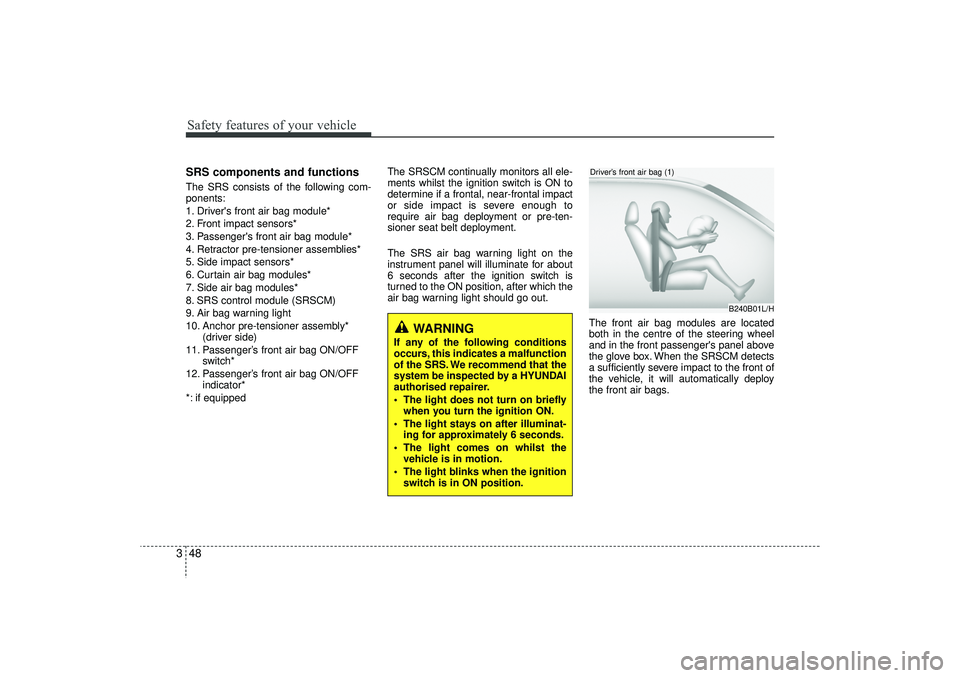
Safety features of your vehicle48
3SRS components and functionsThe SRS consists of the following com-
ponents:
1. Driver's front air bag module*
2. Front impact sensors*
3. Passenger's front air bag module*
4. Retractor pre-tensioner assemblies*
5. Side impact sensors*
6. Curtain air bag modules*
7. Side air bag modules*
8. SRS control module (SRSCM)
9. Air bag warning light
10. Anchor pre-tensioner assembly*
(driver side)
11. Passenger’s front air bag ON/OFF switch*
12. Passenger’s front air bag ON/OFF indicator*
*: if equipped The SRSCM continually monitors all ele-
ments whilst the ignition switch is ON to
determine if a frontal, near-frontal impact
or side impact is severe enough to
require air bag deployment or pre-ten-
sioner seat belt deployment.
The SRS air bag warning light on the
instrument panel will illuminate for about
6 seconds after the ignition switch is
turned to the ON position, after which the
air bag warning light should go out.
The front air bag modules are located
both in the centre of the steering wheel
and in the front passenger's panel above
the glove box. When the SRSCM detects
a sufficiently severe impact to the front of
the vehicle, it will automatically deploy
the front air bags.
WARNING
If any of the following conditions
occurs, this indicates a malfunction
of the SRS. We recommend that the
system be inspected by a HYUNDAI
authorised repairer.
The light does not turn on brieflywhen you turn the ignition ON.
The light stays on after illuminat- ing for approximately 6 seconds.
The light comes on whilst the vehicle is in motion.
The light blinks when the ignition switch is in ON position.
B240B01L/H
Driver’s front air bag (1)
EL(FL) UK 3.QXP 12/16/2014 8:56 PM Page 48
Page 68 of 550
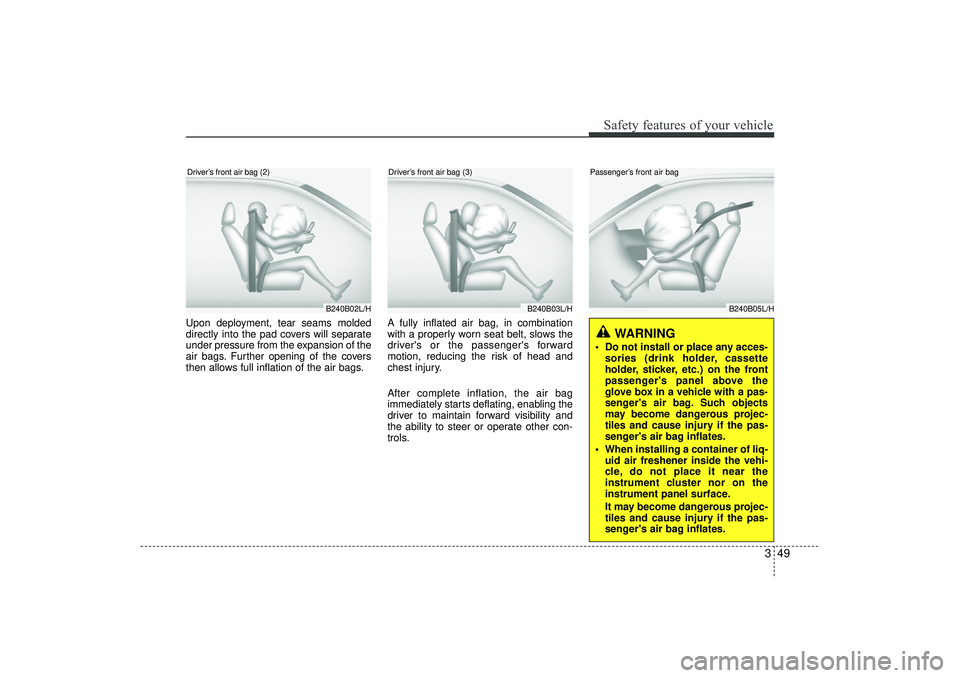
349
Safety features of your vehicle
Upon deployment, tear seams molded
directly into the pad covers will separate
under pressure from the expansion of the
air bags. Further opening of the covers
then allows full inflation of the air bags.A fully inflated air bag, in combination
with a properly worn seat belt, slows the
driver's or the passenger's forward
motion, reducing the risk of head and
chest injury.
After complete inflation, the air bag
immediately starts deflating, enabling the
driver to maintain forward visibility and
the ability to steer or operate other con-
trols.
B240B02L/H
B240B03L/H
Driver’s front air bag (2)
Driver’s front air bag (3)
B240B05L/H
Passenger’s front air bag
WARNING
Do not install or place any acces-
sories (drink holder, cassette
holder, sticker, etc.) on the front
passenger's panel above the
glove box in a vehicle with a pas-
senger's air bag. Such objects
may become dangerous projec-
tiles and cause injury if the pas-
senger's air bag inflates.
When installing a container of liq- uid air freshener inside the vehi-
cle, do not place it near the
instrument cluster nor on the
instrument panel surface.
It may become dangerous projec-
tiles and cause injury if the pas-
senger's air bag inflates.
EL(FL) UK 3.QXP 12/16/2014 8:56 PM Page 49
Page 69 of 550
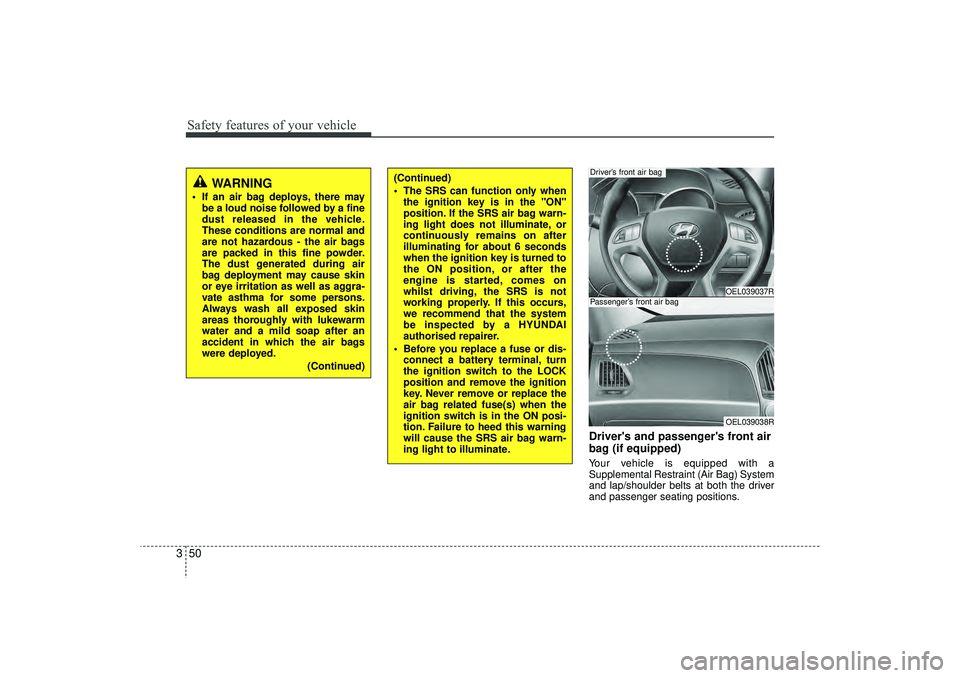
Safety features of your vehicle50
3
Driver's and passenger's front air
bag (if equipped)Your vehicle is equipped with a
Supplemental Restraint (Air Bag) System
and lap/shoulder belts at both the driver
and passenger seating positions.
WARNING
If an air bag deploys, there may
be a loud noise followed by a fine
dust released in the vehicle.
These conditions are normal and
are not hazardous - the air bags
are packed in this fine powder.
The dust generated during air
bag deployment may cause skin
or eye irritation as well as aggra-
vate asthma for some persons.
Always wash all exposed skin
areas thoroughly with lukewarm
water and a mild soap after an
accident in which the air bags
were deployed.
(Continued)
(Continued)
The SRS can function only whenthe ignition key is in the "ON"
position. If the SRS air bag warn-
ing light does not illuminate, or
continuously remains on after
illuminating for about 6 seconds
when the ignition key is turned to
the ON position, or after the
engine is started, comes on
whilst driving, the SRS is not
working properly. If this occurs,
we recommend that the system
be inspected by a HYUNDAI
authorised repairer.
Before you replace a fuse or dis- connect a battery terminal, turn
the ignition switch to the LOCK
position and remove the ignition
key. Never remove or replace the
air bag related fuse(s) when the
ignition switch is in the ON posi-
tion. Failure to heed this warning
will cause the SRS air bag warn-
ing light to illuminate.
OEL039037ROEL039038R
Driver’s front air bagPassenger’s front air bag
EL(FL) UK 3.QXP 12/16/2014 8:56 PM Page 50
Page 70 of 550

351
Safety features of your vehicle
The indications of the system's presence
are the letters "AIR BAG" embossed on
the air bag pad cover on the steering
wheel and the passenger's side front
panel pad above the glove box.
The SRS consists of air bags installed
under the pad covers in the centre of the
steering wheel and the passenger's side
in the front panel above the glove box.
The purpose of the SRS is to provide the
vehicle's driver and/or the front passen-
ger with additional protection than that
offered by the seat belt system alone in
case of a frontal impact of sufficient
severity.
WARNING
Always use seat belts and child
restraints – every trip, every time,
everyone! Air bags inflate with
considerable force and in the blink
of an eye. Seat belts help keep
occupants in proper position to
obtain maximum benefit from the
air bag. Even with air bags, improp-
erly and unbelted occupants can be
severely injured when the air bag
inflates. Always follow the precau-
tions about seat belts, air bags and
occupant safety contained in this
manual.
To reduce the chance of serious or
fatal injuries and receive the maxi-
mum safety benefit from your
restraint system:
Never place a child in any child orbooster seat in the front seat. NB
See section - Passenger's front
air bag ON/OFF switch (if
equipped).
ABC – Always Buckle Children in the back seat. It is the safest
place for children of any age to
ride.
(Continued)
(Continued)
Front and side air bags can injureoccupants improperly positioned
in the front seats.
Move your seat as far back as practical from the front air bags,
whilst still maintaining control of
the vehicle.
You and your passengers should never sit or lean unnecessarily
close to the air bags. Improperly
positioned drivers and passen-
gers can be severely injured by
inflating air bags.
Never lean against the door or centre console – always sit in an
upright position.
No objects should be placed over or near the air bag modules on
the steering wheel, instrument
panel, and the front passenger's
panel above the glove box,
because any such object could
cause harm if the vehicle is in a
crash severe enough to cause
the air bags to deploy.
(Continued)
EL(FL) UK 3.QXP 12/16/2014 8:56 PM Page 51